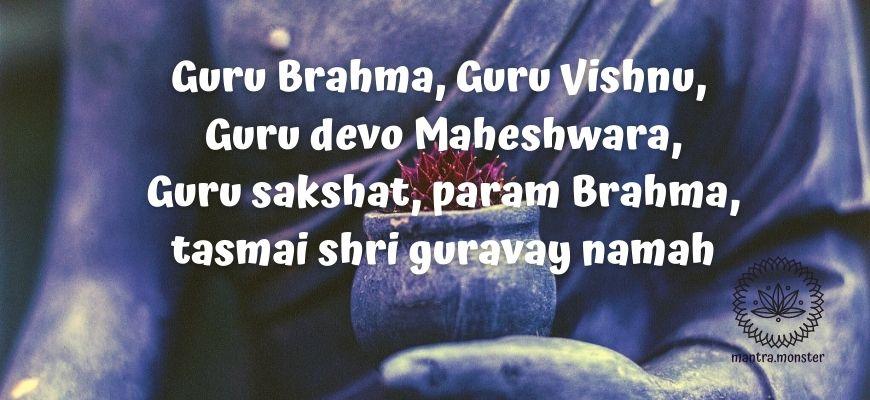Guru Brahma Guru Vishnu mantra lyrics in Sanskrit:
„Guru Brahma, Guru Vishnu, Guru devo Maheshwara,
Guru sakshat, param Brahma, tasmai shri guravay namah.”
Guru Brahma Guru Vishnu Devo Maheshwara mantra translation and meaning:
„The guru is the creator, the guru is the preserver, and the guru is the destroyer. The guru is the absolute. I bow before you.”
Description
Lord Brahma is the Hindu Creator god. He is also known as Svayambhu (self-born) and Vagisa (Lord of Speech), and the creator of the four Vedas, one from each of his mouths. In early Hindu sources, such as the Mahabharata, Lord Brahma is supreme in the triad of great Hindu gods which includes Lord Shiva and Lord Vishnu. In the late Vedic period, He was called Prajapati, the primeval man whose sacrifice permitted the original act of creation.
While He is commonly credited as the creator of the universe and various beings in it, a few Puranas describe Him being born from a lotus emerging from the navel of Lord Vishnu. Thus comes one of his names Nabhija (born from the navel). The spiritual concept of Brahman is very old, and some Hindu scholars suggest that Lord Brahma may have emerged as a personal conception and visible icon of the impersonal universal principle called Brahman.
One of the earliest mentions of Lord Brahma with Lord Vishnu and Lord Shiva is in the 5th Prapathaka of the Maitrayaniya Upanishad (an ancient Sanskrit writing), most likely composed in late 1st millennium BCE. He is discussed in verse 5,1, also called the Kutsayana Hymn first, and expounded in verse 5,2.
Lord Brahma is still honoured today with an annual ceremony at the pilgrimage site of Pushkar in Rajasthan, India. The Creator Hindu god remains a popular figure in South-east Asia, particularly in Bali and Thailand. Annually, on Kartik Poornima, the full moon night of the Hindu lunar month of Kartik (October – November), a religious festival is held in Lord Brahma’s honour. Moreover, the largest and most famous shrine to Lord Brahma may be found in Cambodia’s Angkor Wat.
Iconography
He is usually depicted in red with 4 heads (the heads represent the 4 yugas – krita, treta, dwapara, kali, the 4 Vedas – Atharva, Rig, Yajur, Sama, and the 4 varnas – sudra, brahmana, kshatriya, vaisya). Furthermore, He is traditionally portrayed with four arms, with none holding a weapon, unlike most other Hindu Gods.
These four arms are holding up different objects, such as – kurcha (kusha grass), sruk (ladle), kamandala (water pot), sruva (spoon), and pustaka (book) and in different poses signifying the four quartem. He also holds a string of malas (prayer beads) that He uses to keep track of the Universe’s time.
Moreover, He is also shown holding the Vedas, and sometimes, a lotus flower. Lord Brahma’s vehicle is a divine Swan. In Tibet, where He is known as White Brahma (Tshangs-pa dkar-po) or Tshangs-pa, He frequently rides a horse and carries a white bull and a sword.








